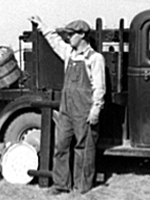
Ford, QuentinAboutFord talks about sheepherder wagons he remembers from his youth on the San Augustin plains.
Abstract
Tape 1, Side A
Ford describes the sheep wagon on display in the Sheep & Goat Barn as being typical of the wagons he recalls from his youth. The Hubble and Luna family members made their own sheep wagons and mounted them on an old Model T frame with rubber tires, as he recalls. Some of the wagons he remembers were pulled by horses or a pickup; it depended on the location and terrain of the area the herder needed to be in. Ford recalls eating at sheep wagons. His grandfather knew a lot of the herders. Herders would usually cook mutton stew in a Dutch oven and simmer it all morning. It would be served with biscuits at lunch. Mostly one herder was needed to watch one herd, but often there were two herds with one herder per herd. Herders would park a wagon near a water source and stay until the pasture was used up before moving on to another area of grass that was also near a water source. If horses were used to pull the wagon, they were also used to round up the sheep. Dogs were also used to round up the sheep. He remembers the sheep as a mixed herd. Most of them would be white, but there were also some black or brown mixed in. Ford remembers that he and his father would go in the spring and get "dogie" lambs. An ewe often has twins or triplets and often accepts only one or two. Ford recalls that you could buy the "dogies" for about fifty cents each. The Fords would take them home and fatten them up on milk and food, and then have lamb chops in the fall. His mother would take a baby bottle and get the lambs started drinking from a bottle. They made a trough with nipples along the side of the trough. Milk was poured into the trough and the lambs would come and drink there. Ford says the biggest problem was that his mother would name the lambs and make pets out of them. As a result it was always traumatic event to butcher them in the fall. Herders were predominantly local Hispanics from the general area. A herder was gone six months of the year, and his wife was left at home to raise the children. It was a very hard life for the families. They were poor. Ford did not know any Basque herders when he was young, but he has since gotten to know many of them. Peter Mocho was one of his best friends. Referring to the sheep wagon on exhibit, Ford says that it is a little larger than he recalls. It is similar in shape and appearance, but fancier. He adds that the wagon was intended as a place for storing supplies and a place for the herders to get out of the weather. Ford concludes that sheep wagons were definitely used. He enjoyed eating lunch with some of the herders. The lamb stew was made of potatoes, lamb meat, onion, and tomatoes. There would also be some chile added to it as well. It was sometimes served with tortillas. Ford recalls that herders would mark the sheep in the spring, spraying the wool with spray painted as identification. Sometimes at one camp there might be two herders together from different herds. The sheep would need to be separated so each herder had a mark that they used to identify his herd. The interviewer recalls his father marking the sheep with spray paint in the shape of his brand. The herder's markings were not permanent brands and were sheared off the sheep when the wool was sheared off. Ford was born in Glenwood, N.M. in 1923. He was seeing the sheep wagons in the late 1920s to early 1930s. His grandfather had stores in that area, and was active in politics. Although his grandfather never ran for office, Ford would often go with him as he interacted with people he sold to or financed. Ford says his grandfather wanted to be sure that they kept in line politically. His grandfather had stores in Reserve, Alma, and Glenwood. Ford describes it as "an early day equivalent to WalMart" in the sense that they sold everything. It was a mercantile — hardware, groceries, feed. He says, "If you wanted something we could get it for you, and if you wanted to sell something we would probably buy it from you." Almost all trade was either barter or on credit, and you paid once or twice a year when you sold cattle or sheep. His grandfather spoke fluent Spanish; "he was more comfortable in Spanish than he was in English." Ford recalls that that was not unusual in that area and says that he thought you had to be Irish to speak Spanish. "Almost everybody spoke Spanish, but not everybody spoke English." When asked if he had ever heard of R. C. Patterson that lived at Horse Springs, Ford says that although he did not know the man he had been to his place. His grandfather knew him. He states that R. C. Patterson was one of the early non-Hispanic settlers in that area and had come from Maine. The interviewer, [Laumbach] states that he has read some newspaper articles written about Patterson and that he was one of the original settlers of Cañada Alamosa. Ford believes that he was the only Anglo there in Monticello and that he was a translator or guide. Laumbach states that Patterson's wife was Hispanic and says that there is a story about how he gained the respect of the Apache. |

